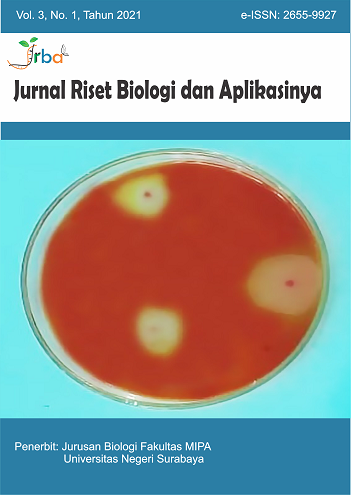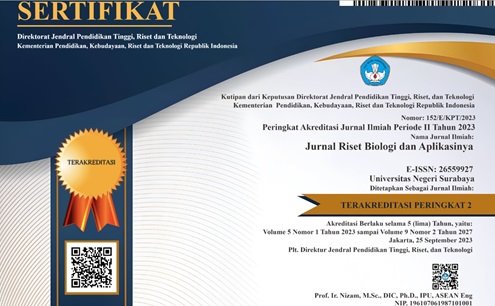The Comparison of SARS-CoV-2, SARS-CoV, and MERS-CoV Genome and Spike Protein Variations
DOI:
https://doi.org/10.26740/jrba.v3n1.p38-44Keywords:
SARS-CoV-2, MERS-CoV, SARS-CoV, Spike Protein, Corona Virus Genome, RBMAbstract
SARS-CoV-2 is a virus that has caused COVID-19 pandemic. This virus is a new variant of the SARS-CoV virus and also closely related to MERS-CoV, which caused similar acute respiratory infections. All these viruses recognize target cells by binding to the Receptor Binding Domain (RBD) on Spike protein with receptors. This study aimed to determine the SARS-CoV-2, MERS-CoV, and SARS-CoV genome structure, Spike protein sequence differences, and variations of RBDs Receptor Binding Motif (RBM). This research was using data mining approach. Genome sequences were downloaded from NCBI, except for Indonesian samples were downloaded from GISAID. Genomic structures, Spike sequence, and RBD structure were analyzed using Bioedit, followed by protein modelling using SwissModel and PyMol applications. The result showed that the SARS-CoV-2, MERS-CoV, and SARS-CoV genome shared the same genes yet in different numbers and length. SARS-CoV-2 Spike protein sequence was quite similar to SARS-CoV Spike protein, but very different to the Spike protein of MERS-CoV. There were variations of RBDs RBM structure due to the mutations occurred among these viruses. It is suggested that these differences may increase the affinity between SARS-CoV-2 Spike protein to its hACE2 receptor which caused SARS-CoV-2 becomes more infective and spread wider than SARS-CoV and MERS-CoV, in turn. This result expected to be basic information for the development of SARS-CoV-2 introduction inhibition agent and spreading prevention.
References
Awasthi, M., & Sarkar, D. P. (2020). N-terminal domain ( NTD ) of SARS-CoV-2 spike- protein structurally resembles MERS-CoV NTD sialoside-binding pocket. 111.
Bai, C., & Warshel, A. (2020). Critical Differences between
the Binding Features of the Spike Proteins of SARS-CoV-2 and SARS-CoV. Journal of Physical Chemistry B, 124(28), 59075912. https://doi.org/10.1021/acs.jpcb.0c04317.
Chakraborty, H., & Bhattacharjya, S. (2020). Mechanistic insights of host cell fusion of SARS-CoV-1 and SARS-CoV-2 from atomic resolution structure and membrane dynamics. Biophysical Chemistry, 265(June), 106438. https://doi.org/10.1016/j.bpc.2020.106438.
De Wit, E., Van Doremalen, N., Falzarano, D., & Munster, V. J. (2016). SARS and MERS: Recent insights into emerging coronaviruses. Nature Reviews Microbiology, 14(8), 523534. https://doi.org/10.1038/nrmicro.2016.81.
Devaux, C. A., Rolain, J. M., & Raoult, D. (2020). ACE2 receptor polymorphism: Susceptibility to SARS-CoV-2, hypertension, multi-organ failure, and COVID-19 disease outcome. Journal of Microbiology, Immunology and Infection, 53(3), 425435. https://doi.org/10.1016/j.jmii.2020.04.015.
Gussow, A. B., Auslander, N., Faure, G., Wolf, Y. I., Zhang, F., & Koonin, E. V. (2020). Genomic determinants of pathogenicity in SARS-CoV-2 and other human coronaviruses. Proceedings of the National Academy of Sciences of the United States of America, 117(26), 1519315199. https://doi.org/10.1073/pnas.2008176117.
Hartenian, E., Nandakumar, D., Lari, A., Ly, M., Tucker, J. M., & Glaunsinger, B. A. (2020). The molecular virology of coronaviruses. Journal of Biological Chemistry, 295(37), 1291012934. https://doi.org/10.1074/jbc.REV120.013930.
Hoffmann, M., Kleine-Weber, H., Schroeder, S., Krüger, N., Herrler, T., Erichsen, S., Schiergens, T. S., Herrler, G., Wu, N. H., Nitsche, A., Müller, M. A., Drosten, C., & Pöhlmann, S. (2020). SARS-CoV-2 Cell Entry Depends on ACE2 and TMPRSS2 and Is Blocked by a Clinically Proven Protease Inhibitor. Cell, 181(2), 271-280.e8. https://doi.org/10.1016/j.cell.2020.02.052.
Hulswit, R. J. G., de Haan, C. A. M., & Bosch, B. J. (2016). Coronavirus Spike Protein and Tropism Changes. In Advances in Virus Research (1st ed., Vol. 96). Elsevier Inc. https://doi.org/10.1016/bs.aivir.2016.08.004.
Mizumoto, K., & Chowell, G. (2020). Estimating the risk of 2019 Novel Coronavirus death during the course of the outbreak in China, 2020. MedRxiv, 191192. https://doi.org/10.1515/9780822396086-023.
Mousavizadeh, L., & Ghasemi, S. (2020). Genotype and phenotype of COVID-19: Their roles in pathogenesis. Journal of Microbiology, Immunology and Infection, xxxx, 04. https://doi.org/10.1016/j.jmii.2020.03.022.
Saha, O., Shatadru, R. N., Rakhi, N. N., Islam, I., & Rahaman, M. (2020). possible implications from the ongoing outbreak in Bangladesh.
Sahu, K. K., Mishra, A. K., & Lal, A. (2020). Comprehensive update on current outbreak of novel coronavirus infection (2019-nCoV). Annals of Translational Medicine, 8(6), 393393. https://doi.org/10.21037/atm.2020.02.92.
Shang, J., Ye, G., Shi, K., Wan, Y., Luo, C., Aihara, H., Geng, Q., Auerbach, A., & Li, F. (2020). Structural basis of receptor recognition by SARS-CoV-2. Nature, 581(7807), 221224. https://doi.org/10.1038/s41586-020-2179-y.
Sicari, D., Chatziioannou, A., Koutsandreas, T., Sitia, R., & Chevet, E. (2020). Role of the early secretory pathway in SARS-CoV-2 infection. Journal of Cell Biology, 219(9), 113. https://doi.org/10.1083/JCB.20200600508132020C.
Tosepu, R., Gunawan, J., Effendy, D. S., Ahmad, L. O. A. I., Lestari, H., Bahar, H., & Asfian, P. (2020). Correlation between weather and Covid-19 pandemic in Jakarta, Indonesia. Science of the Total Environment, 725. https://doi.org/10.1016/j.scitotenv.2020.138436.
Walls, A. C., Park, Y. J., Tortorici, M. A., Wall, A., McGuire, A. T., & Veesler, D. (2020). Structure, function and antigenicity of the SARS-CoV-2 spike glycoprotein. BioRxiv, January. https://doi.org/10.1101/2020.02.19.956581.
Wan, Y., Shang, J., Graham, R., Baric, R. S., & Li, F. (2020). Receptor Recognition by the Novel Coronavirus from Wuhan: an Analysis Based on Decade-Long Structural Studies of SARS Coronavirus. Journal of Virology, 94(7), 19. https://doi.org/10.1128/jvi.00127-20.
Watanabe, Y., Allen, J. D., Wrapp, D., McLellan, J. S., & Crispin, M. (2020). Site-specific glycan analysis of the SARS-CoV-2 spike. Science, 369(6501), 330333. https://doi.org/10.1126/science.abb9983.
Wu, Y., Ho, W., Huang, Y., Jin, D. Y., Li, S., Liu, S. L., Liu, X., Qiu, J., Sang, Y., Wang, Q., Yuen, K. Y., & Zheng, Z. M. (2020). SARS-CoV-2 is an appropriate name for the new coronavirus. The Lancet, 395(10228), 949950. https://doi.org/10.1016/S0140-6736(20)30557-2.
Xia, S., Liu, M., Wang, C., Xu, W., Lan, Q., Feng, S., Qi, F., Bao, L., Du, L., Liu, S., Qin, C., Sun, F., Shi, Z., Zhu, Y., Jiang, S., & Lu, L. (2020). Inhibition of SARS-CoV-2 (previously 2019-nCoV) infection by a highly potent pan-coronavirus fusion inhibitor targeting its spike protein that harbors a high capacity to mediate membrane fusion. Cell Research, 30(4), 343355. https://doi.org/10.1038/s41422-020-0305-x.
Xu, R., Shi, M., Li, J., Song, P., & Li, N. (2020). Construction of SARS-CoV-2 Virus-Like Particles by Mammalian Expression System. Frontiers in Bioengineering and Biotechnology, 8(July), 16. https://doi.org/10.3389/fbioe.2020.00862.
Zhou, P., Yang, X. Lou, Wang, X. G., Hu, B., Zhang, L., Zhang, W., Si, H. R., Zhu, Y., Li, B., Huang, C. L., Chen, H. D., Chen, J., Luo, Y., Guo, H., Jiang, R. Di, Liu, M. Q., Chen, Y., Shen, X. R., Wang, X., ¦ Shi, Z. L. (2020). A pneumonia outbreak associated with a new coronavirus of probable bat origin. Nature, 579(7798), 270273. https://doi.org/10.1038/s41586-020-2012-7.
Zhu, Z., Lian, X., Su, X., Wu, W., Marraro, G. A., & Zeng, Y. (2020). From SARS and MERS to COVID-19: A brief summary and comparison of severe acute respiratory infections caused by three highly pathogenic human coronaviruses. Respiratory Research, 21(1), 114. https://doi.org/10.1186/s12931-020-01479-w.
Downloads
Published
How to Cite
Issue
Section
 Abstract views: 1147
,
Abstract views: 1147
, PDF Downloads: 910
PDF Downloads: 910












